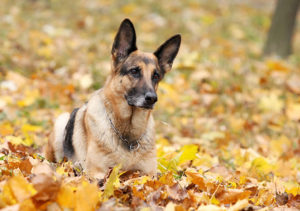Teach your dog how to heel correctly – Part 6

Now it’s time to find out if your dog has truly learned how to heel and execute an automatic sit.
Give him the command “Heel” and make any necessary corrections for poor heeling or lack of attentiveness to bring him up to the proper mental level of awareness. Come to a stop and command “Sit”. Watch your dog do it all by himself. Get down to his level and praise him enthusiastically.
For the stubborn or uncooperative dog who would rather be helped for the rest of his life, you’ll be surprised to see that he is going to graduate from being spoon-fed whether he wants to or not.
How do you do this? When you come to a stop and command “Sit”, silently count to three. If your dog is not seated by the time you get to three, place both hands on the leash, making sure that there’s a little slack in it, and jerk straight up! Your dog will immediately sit if you make the correction strongly enough. Don’t forget the praise when you’re done.
If he still refuses to sit after the initial correction, consider that correction ineffective. An ineffective correction is inhumane because it means that you will have to keep doing it. This is unfair to your pet and will only create resistance. If you simply tighten the collar around his neck by pulling up slowly on the leash, the only thing you can accomplish is constriction of your dog’s breathing, and you have caused your dog’s training collar to turn into a choking chain.
This is your fault, not his, and he is going to wonder why you have suddenly decided to choke him. So, in all fairness to your dog, make a humane correction by an emphatic and upward jerk of the leash using both hands. Make the correction properly the first time, and chances are you will not have to make it again. Remember to follow the correction with loving praise the moment your dog has responded correctly.
The heel and sit combinations should be continued for one week, after which time you will notice that it’s no longer necessary for you to command “Sit” every time you stop. Your dog will realize that this is what is expected when he is out on a walk and you suddenly come to a stop.
At the end of a week, you can begin dropping the command “Sit” since he will be doing it automatically anyway. Be sure, however, that anytime he fails to sit, make the correction immediately, followed by praise.
Congratulations!
Now you have the proper tools to teach your dog to walk beside you and to sit automatically at your side each time you stop. Why is this crucial? In addition to getting your dog’s attention, which is necessary in order to take him to more advanced levels of training, it will make all the difference in the world when you take him for a walk down a busy street or a crowded place.
Should you stop to talk to someone, your dog is trained to sit at your side patiently, rather than jumping on the person you’re talking to or wrapping the leash around your legs and making a nuisance of himself.



